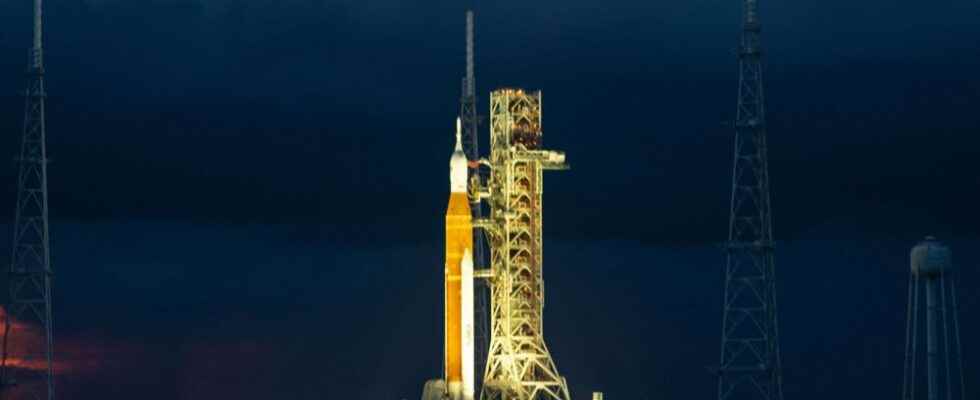With the Artemis program, America is finally reviving dreams of space exploration. After a first aborted launch attempt on August 29 due to technical issues, another date should be set for September 5.
The symbol could have been perfect. The first mission to the Moon for fifty years taking off shortly after the anniversary of the death of Neil Armstrong, on August 25, 2012… But how could such an event be predicted with such precision? Especially when, before going around the Moon, you come back from so far away, and even from what could look like a black hole…
Read also: Thomas Pesquet comes out of his hinges on Twitter, tired of conspiracies
It was almost twenty years ago, in 2004, under the presidency of George W. Bush, that the decision was made to reconnect with John Fitzgerald Kennedy’s dream and once again push back the human frontier. This program, baptized “Constellation”, Barack Obama sent it back to nothingness. Although the American media are reluctant to recognize it, it is Donald Trump who has the honor of having given back his impetus to the adventure. And even to have woken up the boss of NASA, who had envisaged it for 2028. In the name of “the greatness of America”, he was going to receive the order to shorten his deadlines by four years!
The captain, baptized Moonikin, is dressed in the space suit that the next astronauts will use, supposed to be able to provide them with up to six days of autonomy in the event of an accident.
© DR
Artemis must adopt a very oval orbit, moving it 64,300 kilometers away from the Moon, then bringing it back to less than 100 kilometers, which will take about fifteen days. The first flight will be without humans. Three mannequins will have taken place in the capsule: the life-size “commander”, named Moonikin Campos, and his two assistants, Helga and Zohar, who are reduced to trunks, but equipped with 5600 sensors allowing analyze in detail the biological behavior of their successors. Because the takeoff of this first rocket is the prelude to a launch campaign which will include two other components. In 2024, Artemis II (very similar to the 1968 Apollo 8) will send a crew into orbit around the Moon that will not land there. It is Artemis III, scheduled for 2025, which will see astronauts tread the lunar soil, the first since Eugene Cernan on Apollo 17, in 1972.
This first step, a priori not a size 43, will be that of a woman, the sex of nine of the 18 preselected astronauts, which explains the choice of the name of the mission: Artemis, Greek goddess of the Moon. After the first woman, a man who should be “colored”.
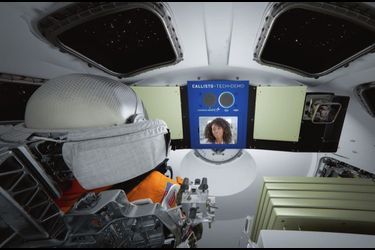
In the upper module of the capsule, touch screens will serve as an interface with the Earth.
© DR
Since Apollo, the real adversaries and rivals of the Americans have changed. They are more Chinese than Russian, but, among all the differences identified with the program developed in the 1960s, the most important is the objective: NASA does not return to the Moon to simply walk there, but to s install there. Irreversibly. It is therefore a question of making possible the almost permanent presence of human beings there. First in orbit, then beyond…
Soon the Moon will be a gas station on the way to Mars
In July 1969, Buzz Aldrin, the second man to walk on the Moon, was preaching in the desert when he advocated for Mars exploration. Today, NASA has listed around fifty milestones to achieve this. A date is even set, the years 2030-2040. As the head of the Astronaut Office Reid Wiseman recalls: “When we talk about Artemis, we focus on the Moon, of course. But I want to remind you that this is not our final objective. It is clearly Mars!” However, if we reach the Moon in three days, a return mission to Mars will require approximately… five hundred.
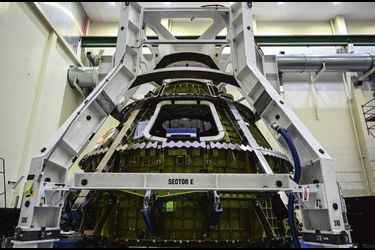
The Orion capsule, 7 meters high, 5 wide. At its base, the “engine room” – 33 engines, 4 large solar panels, systems supplying water, oxygen and fuel – designed by the European Space Agency.
© C. Khanna/AFP
The enterprise is titanic, to the point that NASA has chosen to involve other countries. Canada and Japan in particular, but especially the Esa (European Space Agency). It is to European engineers that we owe the logistics of the survival module that equips the Orion capsule where the astronauts will live. The management of water, oxygen, temperature, the power of the 33 engines and 11 kilometers of cables is the result of Europe’s now recognized know-how in space matters.
It’s obvious, but the first big problem in space exploration remains gravity. To extract oneself from the pull of our planet, one must reach a velocity (the “escape velocity”) of 11 km per second. The most powerful rocket ever built by the Americans (SLS, Space Launch System) is essentially used for this: to propel Orion, the cockpit where the astronauts live. The first advantage of establishing a base on the Moon is obviously due to its proximity to the Earth, but also to the presence of a much lower gravity which will therefore not require the same power of release.
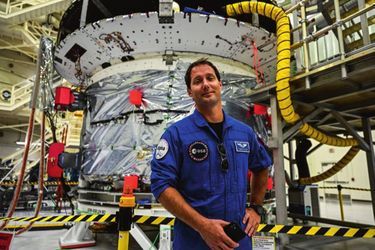
Before manned flights, a very attentive astronaut: Thomas Pesquet, in front of the European module for the Artemis II mission at the Kennedy Space Center, on August 28.
© C. Khanna/AFP.
In addition, a rocket landing on empty tanks could find the means to refuel there. This is the reason why the thirteen potential landing sites were all chosen at the South Pole, where water was detected. By electrolysis, it will be possible to break the molecules to separate the hydrogen and oxygen atoms and make fuel. The Moon would become a kind of service station for rockets bound for Mars.
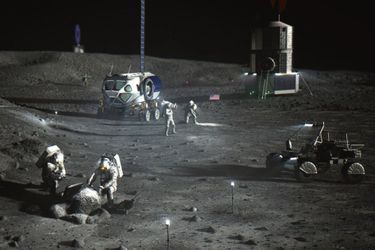
Artist’s impression of a lunar base at the South Pole: with a rover and a pressurized vehicle, the astronauts work to exploit the ground.
© DR
Getting there won’t be easy. It is an adventure that will require infrastructures and personnel, human and robotic, in a sustainable way. The first Artemis mission is scheduled for forty-two days, a period close to the forty-five days envisaged when the first base is established, preferably inside a crater, in order to minimize the impact of solar radiation ( there is no atmosphere on the Moon to protect against it) and that of possible asteroids which would come, without noise, to strike the astronauts. The modules would probably be built using 3D printers and should allow relative autonomy, at least in water, if we manage to recover it under the regolith (part of the ground covering the source rock) at 1 meter from depth, to extract oxygen. Because it is, of course, the other key element of the permanent presence of man on the Moon.
The next moonwalker will be a woman
Among the useful accessories, we will also find a convertible rover, to be used with a combination, as well as a mobile home allowing you to move without resorting to it. The equivalent of what Matt Damon does in “Alone on Mars”. If all goes as planned, the crew of Artemis III will land using the lander manufactured by SpaceX, for a mission of six and a half days. Twice as long as Apollo 17, the longest lunar mission.
Another aspect of this colonization of our satellite: the Lunar Gateway, or “lunar portal”. This kind of manned space station, much smaller than the ISS (1/6 of its size), will navigate between the Earth and the Moon. Replacement equipment and personnel may come and dock there. It will no longer take a big launch to supply the lunar base, but regular take-offs, which are simpler and therefore less expensive. With Mars always in the ultimate line of sight.
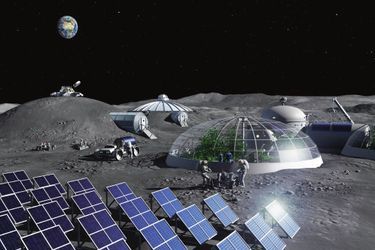
Solar panels, crop facilities: the base is intended to be sustainable.
© DR
Hopefully all goes well, as the program, which has long been over budget, is $93 billion! It is true that Apollo had cost the current equivalent of 280 billion dollars.
The exploitation of lunar resources is already opening up many appetites: six countries and several private companies have officially applied to take part in some 250 missions to the Moon. In France, a man is particularly interested in the success of Artemis: Thomas Pesquet. Given the importance of ESA’s involvement, and even if NASA has not officially announced it, it is almost certain that a seat will be reserved for a European astronaut, if not during the first manned mission, surely for the next, Artemis IV. So why not him? In 2027, Thomas Pesquet will be 44 years old. The age of all possibilities.
